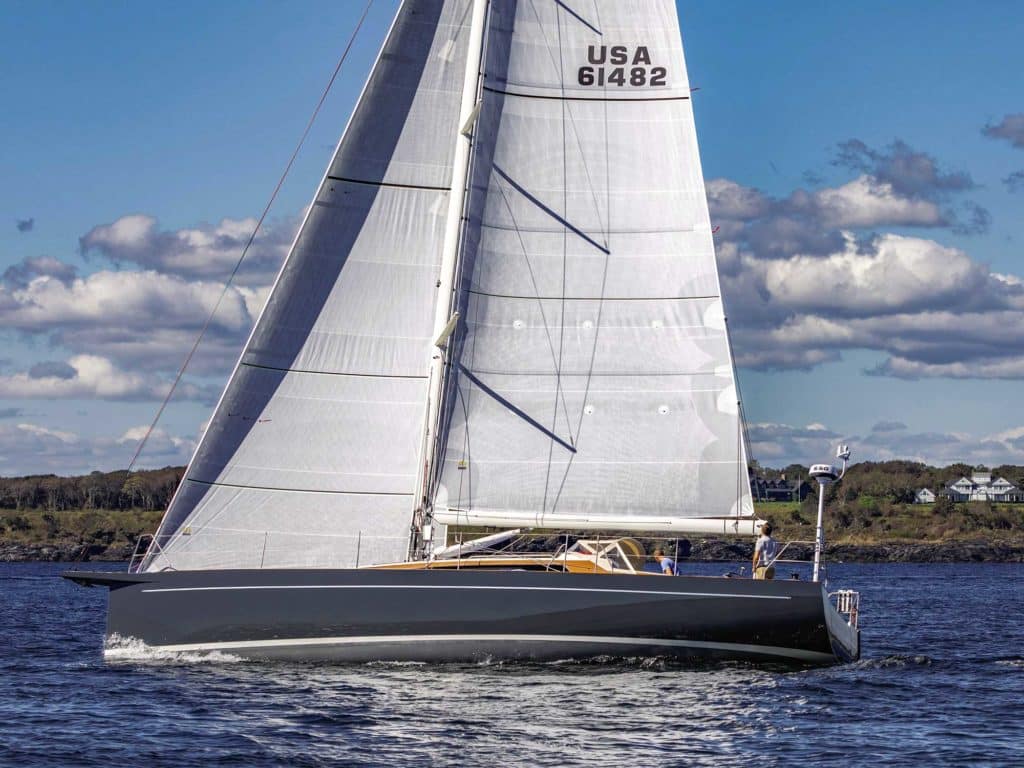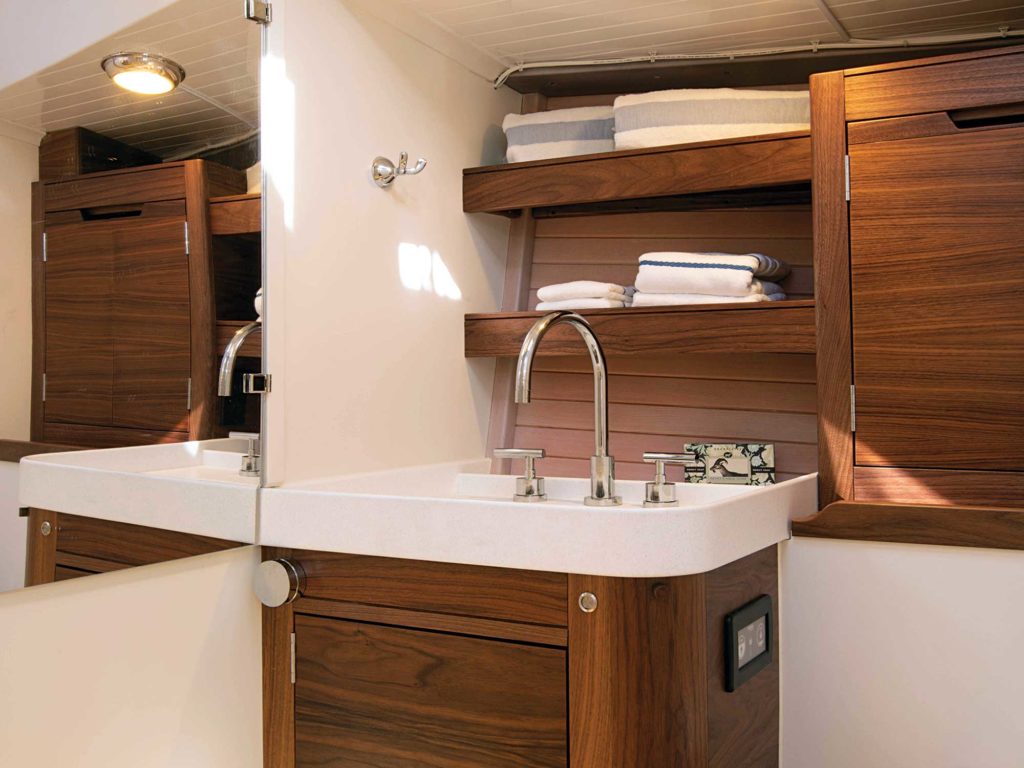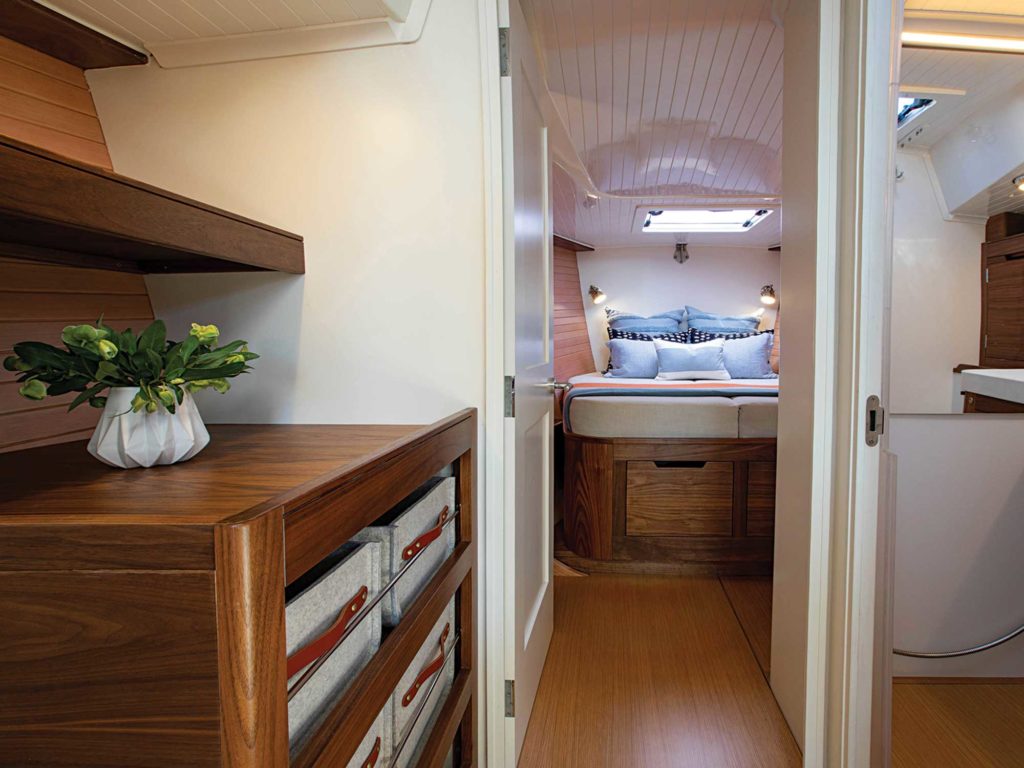
The cold front had passed overnight, and even though it was the middle of July, the fresh northwesterly off the coast of Camden, Maine, had the crisp, clear aura of an early-fall morning. In other words, it was a perfect day to go for a sail. Happily, given that I’d found myself aboard just about the ideal yacht to do so: a slick new Lyman-Morse LM46, a semicustom homegrown beauty constructed at the longtime Maine builder’s facility in nearby Thomaston.
Hopgrasser, the first of two LM46s to emerge from the shed, was company president Drew Lyman’s personal ride, so named by his young daughter, who’d found it linguistically challenging to put the “grass” in front of the “hop.”
The unique name is in keeping with a special, quite inimitable sailboat. Designed by New Zealander Kevin Dibley, a naval architect renowned for his flat-out race boats and graceful performance cruisers, the LM46’s objective is fourfold: light but solid build; handsome yet functional lines and accommodations; prowess in light, inshore breeze; and the power and strength for offshore sailing, including events such as the Newport Bermuda Race (which Hull No. 2, Arcadia, knocked off this past summer).
We’ll start with the build, the first of many things that separate the LM46 from the majority of contemporary cruisers; after all, these days you don’t see many wooden boats at your typical boat show. Lyman-Morse earned its reputation and butters its bread by employing cold-molded, infused-epoxy construction with Douglas fir and Western red cedar. An internal carbon frame stiffens the structure, and ties in the shrouds and titanium chain plates (the rudder and stock are also carbon). The composite deck is laminated with a foam core, again in the dual interests of less weight and more strength. My question about what wood was used to fashion the lovely cabin top was met with a laugh: Turns out it’s all composite (keep it light!), to which a vinyl adhesive with a wood pattern is affixed. Tricky.
In profile, this is one of those rare yachts that looks extremely quick and maneuverable just sitting alongside the dock. The understated sheerline dips ever so slightly from bow to stern, accentuating the low-slung, minimalist coachroof. A dedicated carbon sprit forward is home to both the ground tackle and the tack fitting for off-wind runners and reachers, and gives the profile a businesslike effect. Unlike so many modern boats, there’s no hard chine; in fact, the hull tapers inward in its after sections, a design that does the opposite of a chine and narrows the beam, the thinking being there’s less drag when sailing off the breeze. There’s also less freeboard than we’re used to seeing in most new production boats. To my eye, it’s all very striking.
The boat is powered with a straightforward 12-volt system with a Mastervolt Combi charger/inverter, a 60-amp alternator, a solar panel atop the cockpit dodger, and a set of lithium-ion batteries. The B&G Vulcan 7 instrumentation package is standard. A Yanmar 80 hp diesel with saildrive, coupled with a Max-Prop feathering propeller, supplies the propulsion under power.

As a semicustom boat, the LM46 has quite a bit of leeway in the belowdecks layout and accommodations, but the rather traditional setup on Hopgrasser suited me just fine: galley and nav station at the foot of the companionway, opposing settees/berths in the main saloon, a head and shower forward, and an owner’s stateroom forward. (And a real sea berth to starboard, for which I’m a total sucker.) A single head on a 45-footer is also unusual these days, but a second head is an option.
I wondered aloud about the two quarter berths aft, both wide open and not stashed behind doors, which I thought was in keeping with the airy quarters but something you’re more likely to see on a racer than a cruiser. “If you want privacy,” Drew Lyman said with a laugh, “get yourself a hundred-footer.”
I guess for some folks, that might be an option. But they’d miss out on a fantastic sailing experience on a package dedicated to just that.

This I discovered rather quickly as we motored out of Camden and hoisted sail, beginning with a powerful square-topped, full-battened Doyle mainsail. Lyman-Morse promotes simple sailing, with the ability to be off the dock with sails hoisted in less than five minutes. With that norther coursing off the mainland, the seaway in the lee was flat and fast: pretty perfect for trialing a boat that accentuates performance.
Surprisingly, there’s no backstay on the LM46, but rather a pair of check stays that require regular attention. The twin wheels, with Jefa steering, are situated just abaft the cockpit-wide traveler, and a double-ended German-style mainsheet arrangement trims the main, which has three deep reefs, which is my preference for long-distance sailing. It’s all smart and efficient, befitting a true racer/cruiser sensibility.
Hopgrasser draws 6 feet, the shoal option that replaces the standard 7-foot, 7-inch composite fin with attached lead ballast bulb (the Bahamas is definitely in its future; alternatively, there’s also a 10-foot version for owners of a more competitive nature).
Sailing the boat is loads of fun, and certainly athletic. Lyman said he’s still learning the boat but has discovered that the sweet spot when sailing upwind is a 20- to 22-inch heel angle, which you dial in by constantly playing and tweaking the traveler and vang, as you would on a dinghy or certain one-design classes. The Doyle headsail is sheeted in not on tracks, but instead on movable leads with multiple trimming options, which on the LM46 is certainly an enjoyable part of the exercise.
On our test sail, the puffy breeze was all over the place, dipping to around 10 knots in the lulls and kicking in at over 20 knots in the gusts. The one consistent factor in all this was the sheer joy in driving this ultra-sensitive, highly responsive sailing machine. In the lighter airs, Hopgrasser registered about 6.5 knots in upwind mode; that ratcheted up to nearly 10 knots just cracked off slightly when it filled into the upper teens. As far as top speeds are concerned, Lyman said that the second LM46, Arcadia, saw 19.9 on its speedo during the dash to Bermuda. No question—it’s a slippery hull indeed.
The LM46 is not inexpensive, but it epitomizes what my wise old sailing mate Alvah Simon referred to as “heirloom quality,” something so fine and lasting that it might be passed along in one’s family for years and generations to come. Those are high aspirations, certainly. But in the case of Hopgrasser and her sisterships, they’re attainable ones as well.
Lyman-Morse LM46 Hopgrasser Specifications
| LOA | 45’11” |
|---|---|
| LWL | 43’3″ |
| Beam | 13’5″ |
| Draft | 7’7″ (standard); 6’0″ (shoal/performance) |
| Displ. | 24,250 lb. |
| Sail Area | 1,183 sq. ft. |
| D/L | 133 |
| SA/D | 22.6 |
| Water | 156 gal. |
| Fuel | 81 gal. |
| Mast | 63’9” |
| Engine | Yanmar 80 hp diesel w/ saildrive |
| Price (as tested) | $1,600,000 |
| 207-354-6904 | lymanmorse.com |
Herb McCormick is a CW editor-at-large.








